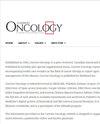Evaluating the Effects of Prostate Radiotherapy Intensified with Pelvic Nodal Radiotherapy and Androgen Deprivation Therapy on Myelosuppression: Single-Institution Experience
IF 2.8
4区 医学
Q2 ONCOLOGY
引用次数: 0
Abstract
Background: Prostate cancer (PCa) management commonly involves the utilization of prostate radiotherapy (PRT), pelvic nodal radiotherapy (PNRT), and androgen deprivation therapy (ADT). However, the potential association of these treatment modalities with bone marrow (BM) suppression remains inadequately reported in the existing literature. This study is designed to comprehensively evaluate the risk of myelosuppression associated with PRT, shedding light on an aspect that has been underrepresented in prior research. Materials and Methods: We conducted a retrospective analysis of 600 patients with prostate cancer (PCa) treated with prostate radiotherapy (PRT) at a single oncology center between 2007 and 2017. Patients were categorized into four cohorts: PRT alone (n = 149), PRT + ADT, (n = 91), PRT + PNRT (n = 39), and PRT + PNRT + ADT (n = 321). To assess the risk of myelosuppression, we scrutinized specific blood parameters, such as hemoglobin (HGB), white blood cells (WBCs), neutrophils (NEUT), lymphocytes (LYM), and platelets (PLT) at baseline, mid-treatment (mRT), immediately post-RT (pRT), 1 month post-RT (1M-pRT), and 1 year post-RT (1Y-pRT). The inter-cohort statistical significance was evaluated with further stratification based on the utilized RT technique {3D conformal radiotherapy (3D-CRT), and intensity-modulated radiation therapy (IMRT)}. Results: Significant statistical differences at baseline were observed in HGB and LYM values among all cohorts (p < 0.05). Patients in the PRT + PNRT + ADT cohort had significantly lower HGB at baseline and 1M-pRT. In patients undergoing ADT, BMS had a significant impact at 1M-pRT {odds ratio (OR) 9.1; 95% Confidence Interval (CI) 4.8–17.1} and at 1Y-pRT (OR 2.84; CI 1.14–7.08). The use of 3D-CRT was linked to reduced HGB levels in the PRT + PNRT + ADT group at 1 month pRT (p = 0.015). Similarly, PNRT significantly impacted BMS at 1M-pRT (OR 6.7; CI 2.6–17.2). PNRT increased the odds of decreased WBC counts at 1Y-pRT (OR 6.83; CI: 1.02–45.82). Treatment with any RT techniques (3D-CRT or IMRT), particularly in the PRT + PNRT and PRT + PNRT + ADT groups, significantly increased the odds of low LYM counts at all time points except immediately pRT (p < 0.05). Furthermore, NEUT counts were considerably lower at 1M-pRT (p < 0.05) in the PRT + PNRT + ADT group. PLT counts were significantly decreased by PRT + PNRT + ADT at mRT (OR 2.57; 95% CI: 1.42–4.66) but were not significantly impacted by the RT technique. Conclusions: Treatment with PRT, ADT, PNRT, and 3D-CRT is associated with BMS. Despite this statistically significant risk, no patient required additional interventions to manage the outcome. While its clinical impact appears limited, its importance cannot be underestimated in the context of increased integration of novel systemic agents with myelosuppressive properties. Longer follow-up should be considered in future studies.评估前列腺放疗加强盆腔结节放疗和雄激素剥夺疗法对骨髓抑制的影响:单机构经验
背景:前列腺癌(PCa)治疗通常包括前列腺放疗(PRT)、盆腔结节放疗(PNRT)和雄激素剥夺疗法(ADT)。然而,这些治疗方式与骨髓(BM)抑制的潜在关联在现有文献中仍未得到充分报道。本研究旨在全面评估与 PRT 相关的骨髓抑制风险,揭示以往研究中代表性不足的一个方面。材料和方法:我们对 2007 年至 2017 年间在一家肿瘤中心接受前列腺放射治疗(PRT)的 600 名前列腺癌(PCa)患者进行了回顾性分析。患者被分为四组:单独PRT(n = 149)、PRT + ADT(n = 91)、PRT + PNRT(n = 39)和PRT + PNRT + ADT(n = 321)。为了评估骨髓抑制的风险,我们仔细检查了基线、治疗中期(mRT)、RT 术后即刻(pRT)、RT 术后 1 个月(1M-pRT)和 RT 术后 1 年(1Y-pRT)的特定血液参数,如血红蛋白(HGB)、白细胞(WBC)、中性粒细胞(NEUT)、淋巴细胞(LYM)和血小板(PLT)。根据所使用的 RT 技术{三维适形放射治疗(3D-CRT)和调强放射治疗(IMRT)}进一步分层,评估队列间的统计学意义。结果:所有组群的 HGB 和 LYM 值在基线时均存在显著的统计学差异(P < 0.05)。PRT + PNRT + ADT队列中的患者在基线和1M-pRT时的HGB明显较低。在接受 ADT 的患者中,BMS 在 1M-pRT {ds ratio (OR) 9.1; 95% Confidence Interval (CI) 4.8-17.1} 和 1Y-pRT (OR 2.84; CI 1.14-7.08)时具有显著影响。PRT+PNRT+ADT组在PRT 1个月时,3D-CRT的使用与HGB水平的降低有关(P = 0.015)。同样,PNRT 对 PRT 1 个月时的 BMS 有明显影响(OR 6.7;CI 2.6-17.2)。PNRT 增加了 1Y-pRT 时白细胞计数下降的几率(OR 6.83;CI:1.02-45.82)。使用任何 RT 技术(3D-CRT 或 IMRT)进行治疗,尤其是在 PRT + PNRT 组和 PRT + PNRT + ADT 组,都会显著增加涟母计数在所有时间点降低的几率(P < 0.05)。此外,PRT + PNRT + ADT 组的 NEUT 计数在 1M-pRT 时明显降低(p < 0.05)。在 mRT 时,PRT + PNRT + ADT 会明显降低 PLT 计数(OR 2.57;95% CI:1.42-4.66),但 RT 技术对 PLT 计数的影响并不明显。结论PRT、ADT、PNRT和3D-CRT治疗与BMS相关。尽管在统计学上存在显著风险,但没有患者需要额外的干预措施来控制结果。虽然其临床影响似乎有限,但在越来越多地使用具有骨髓抑制特性的新型全身性药物的背景下,其重要性不容低估。今后的研究应考虑进行更长时间的随访。
本文章由计算机程序翻译,如有差异,请以英文原文为准。
求助全文
约1分钟内获得全文
求助全文
来源期刊

Current oncology
ONCOLOGY-
CiteScore
3.30
自引率
7.70%
发文量
664
审稿时长
1 months
期刊介绍:
Current Oncology is a peer-reviewed, Canadian-based and internationally respected journal. Current Oncology represents a multidisciplinary medium encompassing health care workers in the field of cancer therapy in Canada to report upon and to review progress in the management of this disease.
We encourage submissions from all fields of cancer medicine, including radiation oncology, surgical oncology, medical oncology, pediatric oncology, pathology, and cancer rehabilitation and survivorship. Articles published in the journal typically contain information that is relevant directly to clinical oncology practice, and have clear potential for application to the current or future practice of cancer medicine.
 求助内容:
求助内容: 应助结果提醒方式:
应助结果提醒方式:


